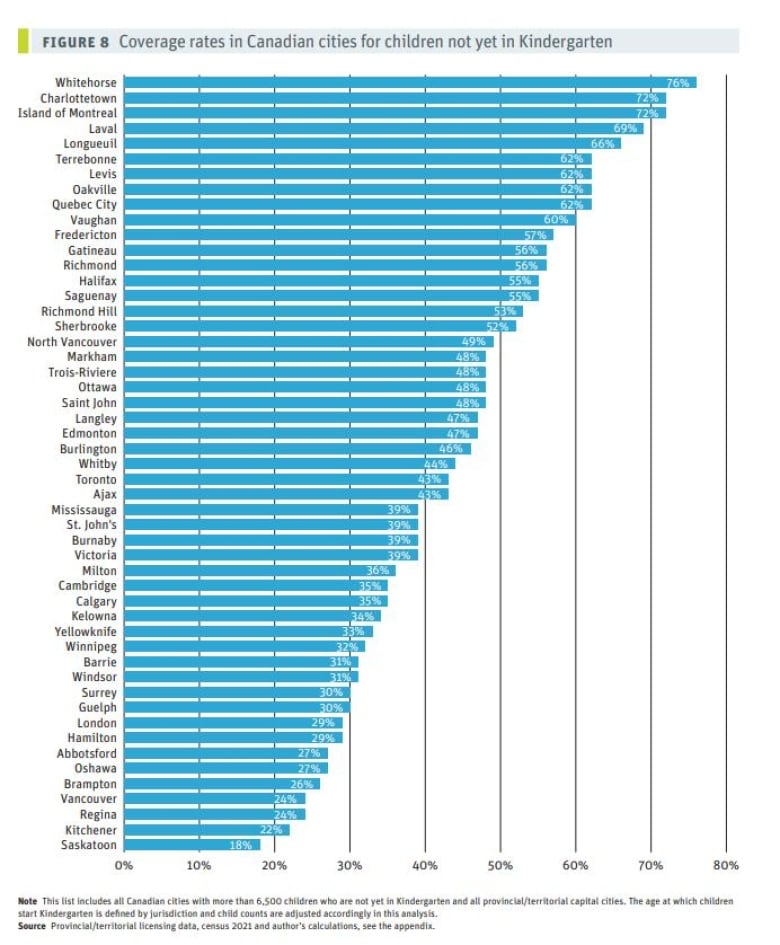
Megan Schmidt is tired of telling parents there is no room for their children at First Years Learning Centre in Regina.
Schmidt, a director at the centre, said she is happy that child care has become more affordable, but her daycare has a wait list of 1,925 kids.
“It’s really, really difficult to just have to turn people away like that. We feel the struggle in parents’ voices when they call and we just [have to] say there’s probably no chance your child will get in here, ” Schmidt said.
“We could open 10 more centres in this area and we would still have a wait list.”
Saskatchewan has the worst child-care deserts in Canada, according to a report by the Canadian Centre for Policy Alternatives (CCPA) titled Not Done Yet: $10-a-day child care requires addressing Canada’s child-care deserts.

The report said 92 per cent of Saskatchewan children who are not yet attending kindergarten live in a postal code with more than three kids competing for every licensed child-care space.
Saskatchewan was the third province to implement $10-a-day child care, achieving the federal target two years early.
“The challenge is that without more spaces, the parents who might want to use that much-more-affordable child care can’t, because there isn’t space,” David Macdonald, a senior economist at CCPA who co-authored the report, told CBC Radio The Morning Edition’s host Stefani Lagenegger.
Macdonald said making some changes in the way child care is delivered could help reduce the number of child-care deserts in the province.
“When it comes to places like Saskatchewan, we need a public planning process that’s more like what you’d see for public schools, ” Macdonald said, “so this is where you’re going to locate public schools — not where it’s most convenient for the school, the school administration, but where it’s most convenient for kids.”
Saskatoon ranked dead last in coverage rates for children not yet in kindergarten among Canadian cities, while Regina has the third worst coverage. However, Macdonald said even more children live in child-care deserts in rural Saskatchewan.

Some government subsidies ending in July
Nichole Kessel is the director Wiggles and Giggles Childcare Inc. in Whitewood, a town 175 kilometres east of Regina. She remembers the stresses and tears that came with adjusting operations to meet the demands of $10-a-day child care under short notice.
Kessel currently receives $10 from the parent and $32 from the government per child. Government subsidies for drop-in and part-time spaces will be ending on July 1, which she said will be devastating for her centre.
“It’s disappointing. It’s exhausting. It’s just very sad,” Kessel said at the Saskatchewan Legislative Building on Tuesday.
“It just feels like a lot of effort we put in might be for nothing and our centre will crumble.”

Kessel, who is also the vice-chair of the Southeast Saskatchewan Directors Association, said about half the centres in the region have committed to cutting some families because there won’t be enough money for staffing and resources.
How is the government supporting the sector?
The Government of Saskatchewan said it has announced wage enhancements for all three levels of early childhood educators in the past two years.
Kessel said some child-care workers in rural communities don’t qualify for those enhancements because they don’t have their early childhood education levels.
She noted that the child-care centre in Whitewood opened in August.
“Who in Whitewood, Saskatchewan, has their early childhood education levels when we’ve never had a daycare before,” Kessel said. “I just had a few of my staff starting to take their levels, but they are making $13.21 an hour when Dairy Queen will start them off at $15.”
“I can’t compete with that.”
Saskatchewan Education Minister Dustin Duncan said the province is working to develop a long-term early childhood educator workforce strategy that will lay out a longer-term vision for growth in the sector and a wage grid to ensure early childhood educators receive competitive wages.

” [We are looking at] an expansion strategy that will look to see where we can expand not only where there is no childcare, but working with centres and regulated family based spaces to see if they can take on additional numbers,” Duncan said during question period on Tuesday.
Duncan did not meet with Kessel on Tuesday.
Kessel wants to see a workforce strategy by June 9 and see a wage grid in play by June 23.
More attractive wages needed to keep up with demand
Angie Stevenson, director of the St. Brieux Community Childcare Centre, said it’s great that child care is becoming more affordable.
She added that kids living in St. Brieux, about 180 kilometres northeast of Saskatoon, are not living in a child-care desert, but the centre is still feeling the crunch of the increased demand.
“We are now seeing a waiting list and we have never had a waiting list before,” Stevenson said. “We have a 78-space facility for a town of 650 people.
“We could have more children attending in a few of our classrooms if I had more qualified early childhood educators, but that is what we’re seeing across Saskatchewan and across Canada.”

Schmidt said there is an immediate need for a wage grid, improved working conditions and benefits.
“I would say that a majority of early childhood educators have two jobs, some might have three,” Schmidt said.
“It would be important for the government to focus on all three of those things in order for us to entice more educators to go into the field and for those that have left to come back,” Schmidt said.












